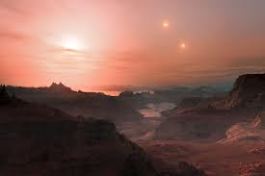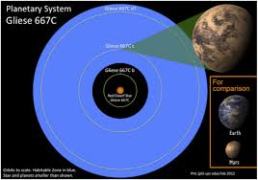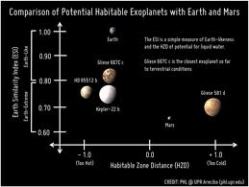Christian Bladon
Mariana Lazarova
PC 120 Life in the Universe
October 20, 2013
Life in a Multiple Star System?
Fig.1 Artist rendition of the planet surface[1]
Introduction
Exoplanets, the great celestial bodies away from our solar system that may one day serve as colonies in the stars to mankind. An exoplanet is a planet outside of our solar system, orbiting a star many light years away from us. Hard to detect, humankind has only learned of their existence in the past 30 years, and cataloging them in the past 20 years. Extremely difficult to identify due to the extreme distances between Earth and them, physicists use a variety of methods, both direct and indirect, to discover them. Researchers use data collected from enormous telescopes, along with extremely advanced mathematics, to measure the gravitational distortion a star might receive from an exoplanet, the change in luminosity a star may present as an exoplanet drifts past it, and the Doppler shift of a star as it moves around its own orbit to identify potential new homes for the human race.
As mankind has become increasingly versed in the layout of the galaxy, it has become apparent that although there are likely many habitable planets out there, there are also many more planets that aren’t. Because Earth is only able to sustain a certain amount of people and their pollution, it has become viable for scientists to search for new planets in the Galaxy to inhabit, so mankind may survive and thrive in future generations. Against the odds of finding much, it is for this reason that research is being funded to discover these potential new homes as quickly as possible. With nearly 300 billion stars in the galaxy, and possibly more planets orbiting them, it is surprising that as recently as 2012, a possibly habitable planet named Gliese 667Cc has been discovered in the Scorpius constellation. Orbiting the star Gliese 667C, part of a three star binary system nearly 22.1 light years away, Gliese 667Cc was discovered using the radial velocity method of exoplanet identification. By measuring the Doppler shift that the star demonstrated in its own orbit, it was deduced that the star had a number of orbiting planetary bodies around it. By measuring the shift in the spectral lines of the star, the change in radial velocity of a star signals that the gravity of an orbiting planet is pulling it (See Equation 1: Radial Velocity due to Planet). Originally discovered this way, the planet was first found by the European Southern Observatory’s HARPS telescopic spectrograph by researchers at the University of Gottingen and Carnegie Institution for Science. The planet as of right now holds the most promise of any yet discovered for a potential home for undiscovered life.
The star itself, Gliese 667C, is extremely different from that of Earth’s sun. With a luminosity only 1.4% of the sun’s, Gliese 667C is a red dwarf star, of the classification M1.5V. Burning at around 3700 degrees Kelvin, the star’s heat hardly compares to the intense 5,778 degrees Kelvin that the sun puts out. Bound in a binary system of three stars, Gliese 667A and 667B orbit each other extremely closer, while Gliese 667C circles the pair from 230 astronomical units away. Speculated to be 2 billion years old, the M type star is much smaller than the Earth’s sun, and so should live for many more billions of years until it finally transitions into its next stage of evolution. Red Dwarfs of the M star type are the most common of all in the galaxy, and take trillions of years to mature. As such, there are currently none in the next stage of evolution.
Thesis
Aside from all of these factors influencing how habitable the planet is, it also resides within the Habitable Zone of Gliese 667C, the distance from the star at which water can be found in liquid form. The combination of all of these make Gliese 667Cc the most likely habitable exoplanet yet discovered, although the vast distance between it and Earth make it only possible to speculate and hypothesize on what the planet is actually like. Despite being extremely similar to Earth, it seems unlikely that the planet is actually habitable, or carries any form of life. Judging by researchers lack of knowledge on the exoplanet, chances are that Gliese 667Cc is for some reason or other inhabitable, due to such reasons as higher infrared radiation, a different atmosphere or the occasional spike in solar activity from the nearby star that could sterilize the planet.
Fig.2 The habitable ring around Gliese 667C[2]
Supporting Data
The planet’s habitability is defined by a multitude of calculations and observations, which point towards its potential for housing life as being more likely than any other planet yet discovered. Gliese 667Cc orbits its star within the habitability zone, the ring around a star between two distances wherein liquid water may form. By multiplying the square root of the star’s luminosity with either .95au, for the inner boundary, or 1.4au, for the outer boundary, the habitable zone edges can be found, and placed against the average distance a planet is from its star (see Equation 2: Habitable Zone Calculation). Next, by taking the planets Albedo, or reflectivity, it is possible to estimate the average surface temperature of a planet, which for Gliese 667Cc is a temperate 277.4 degrees Kelvin. This almost matches Earth’s average temperature, which is 287 degrees Kelvin, with the help of the planet’s atmosphere. Classified as a super-Earth type planet, the mass of Gliese 667Cc is roughly 4.4 times greater than Earth, while still being considered habitable. However, the result of this increased size is that gravity also goes up. On the surface of the planet, is believed that gravity would be twice as strong as that on Earth, meaning a person would weigh twice what they normally do. Due to the planet’s strong similarities to Earth, estimated to be around 90%, it can be assumed that a similar atmosphere would cover the planet, helping the planet retain heat in much the same way as Earth does. It can be assumed that the equation for the planet’s temperature equilibrium, or the average temperature of the planet’s surface in simpler terms. Using the planet’s estimated albedo, which is about 11% that of the Earth, the average temperature on Gliese 667Cc comes out to be 277.4 degrees Kelvin, within 10 degrees Kelvin of Earth’s termperature (see Equation 3: Albedo Calculation / Temperature Equilibrium). However, unlike the sun, Gliese 667C is a much more slowly developing star. Although the Habitable Zone in the solar system will likely shift in the next few billion years, it is unlikely that this will occur at Gliese 667C. This means that if Gliese 667Cc is in fact a habitable exoplanet, it could be used as a home for mankind for an indefinitely great period of time.
Fig. 3 A comparison of Earth against the other possibly habitable planets[3]
Species Speculation
In truth, the surface of the planet is more similar than not to terrestrial locations, such as the Grand Canyon. With deep, trench like canyons acting as the path for relatively shallow rivers, a pleasant biota of flora grow near the edge of the water. Bleached a deep, blood red, the short grass and ferns pick up the increased levels of infrared light from Gliese 667C as a higher source of energy than the visible light on the planet. Most surprising of all, however, is the presence of two main species of conflicting amphibians and reptiles. The amphibians resemble a mix of an eel and a frog, having an extremely elongated body typically two feet in length, with powerful hind-legs, and surprisingly dexterous forearms. Surviving off of algae in the canyon rivers of the planet as a main source of food, this species is in constant evolutionary conflict with the reptile like predators they share the planet with. The reptiles, in contrast to the long shape of the amphibious species, are extremely compact, resembling a rounder version of a Crocodile and a Komodo Dragon. However, what sets them apart as a predator is their right forearm; a retractable arm with razor-like claws capable of rocketing out to full length (about a foot) in less than .03 seconds. Although they may be the only two organisms of complex structure and movement, the two species offer a wide variety of colors and regional mutations that are fairly noticeable. The higher levels of infrared light, combined with the excess radiation of solar flares at a much closer distance to the orbiting star cause mutations to occur within the organisms DNA at a rate nearly 100x that of Earth. Unfortunately, the tidal locking of the planet to its sun means that the planet’s organisms can only survive along a ring a few kilometers in width around the planet, where there is a perpetual state of semi-day and semi-night. If visiting the area, most scientists recommend taking a small raft down one of the many rivers, to reduce impact upon the relatively fragile ecosystem, while also decreasing stress from the planets higher gravity force. These trips are not for the casual adventurer, as the extra force of gravity upon the body calls for a high level of fitness to counteract the natural extra strain put upon the body.
Conclusion
Gliese 667Cc resides as the planet most likely capable of life that we have yet discovered, although there are still discrepancies as a home for potential new life. The lack of information on the planet’s surface will slowly reduce in the coming years as more and more information is gained on the system, although labeling it the “holy grail”[4] of life on an exoplanet may be immature. This does not detract from the excitement over the discovery of the exoplanet, as any new planet with the possibility of life pushes humankind one step closer to branching off from earth, and becoming a space-faring civilization.
Sources
– Wedemeyer-Böhm, Sven. “Life on Gliese 667Cc?” – Institute of Theoretical Astrophysics. Institute of Theoretical Astrophysics, 17 Feb. 2012. Web. 21 Oct. 2013. <http://www.mn.uio.no/astro/english/research/news-and-events/news/astronews-2012-02-17.html>.
– “More Talk About Gliese 667Cc, The “Holy Grail” of Exoplanets.” Space Oddities – What I Didn’t Learn in Science Class. WordPress.org, 28 Apr. 2012. Web. 21 Oct. 2013. <http://lilspaceoddities.wordpress.com/2012/04/28/more-talk-about-gliese-667-cc-the-holy-grail-of-exoplanets/>.
– Creager, Charles, Jr. ” Gliese 667Cc, The Latest “Habitable” Planet.” Gliese 667Cc. N.p., n.d. Web. 21 Oct. 2013. <http://gscim.com/Science_News/4-12/Gliese_667Cc.html>.
– Delfosse, Xavier. “The HARPS Search for Southern Extra-solar Planets. XXXIII. Super-Earths around T.” The HARPS Search for Southern Extra-solar Planets. XXXIII. Super-Earths around T. Astronomy and Astrophysics, May 2012. Web. 21 Oct. 2013. <http://adsabs.harvard.edu/abs/2013A&A…553A…8D>.
– Gregory, Philip C. “Additional Keplerian Signals in the HARPS Data for Gliese 667C from a Bayesian Re-analysis.” Adsabs.harvard.edu. Eprint ArXiv:1212.4058, Dec. 2012. Web. 21 Oct. 2013. <http://adsabs.harvard.edu/abs/2012arXiv1212.4058G>.
Pictures:
http://lilspaceoddities.files.wordpress.com/2012/04/gliese667cc.jpg
Gliese 667Cc (planet) measurements:
Orbital Period: 28.123 days / 2.43 x 106 seconds
Semi-Major Axis: 0.1251 au / 1.87 x 1010 meters
Radial Velocity: 2.1 m/s
85% similarity to Earth
Receives 90% as much light as earth
Mass: 4.45 Earth masses / 2.657 x 1025 kg
Velocity: 48355 m/s
Estimated Temperature: 277.4K
Albedo: 0.11
Gliese 667C (star) measurements:
Classification: Red Dwarf, M1.5
Luminosity: 0.014
Distance to Earth: 6.8 parsecs / 22.1 lightyears
Habitable Zone (me): Dinner = 0.112 au Douter = 0.165 au
Habitable Zone (source): Dinner = 0.095 – 0.126 au Douter = 0.241 – 0.251 au
Mass: 0.31 Orbital Masses / 6.163 x 1029 kg
Radius: 0.42 Solar Radii / 2.92 x 108m
Equation 1: Radial Velocity due to Planet
Vplanet = 2pap = 2 p (1.87 x 1010m) = 48355 m/s
Pp (2429827s)
Ap = Semi-Major Axis (planet)
Pp = Period (planet)
Mstar x Vstar = mplanet x vplanet
(6.163 x 1029 m/s) x Vstar = (2.657 x 1029 kg) x (48355 m/s)
Vstar = 2.1 m/s = radial velocity
Mstar = Mass (star)
Vstar = Velocity (star)
mplanet = Mass (planet)
vplanet = Velocity (planet)
Equation 2: Habitable Zone Calculation:
Dinner = 0.95au(ÖL)
Dinner = .095au (Ö0.014)
Dinner = 0.112au
Douter = 1.4au(ÖL)
Douter = 1.4au(Ö0.014)
Douter = 0.165au
Equation 3: Albedo Calculation / Temperature Equilibrium:
Teq = 278K x (L)1/4 x (1-A)1/4
(ÖD)
L = Luminosity
Teq = Equilibrium Temperature / Average Planet Temperature
A = Albedo / Reflectivity
D = Distance from star



